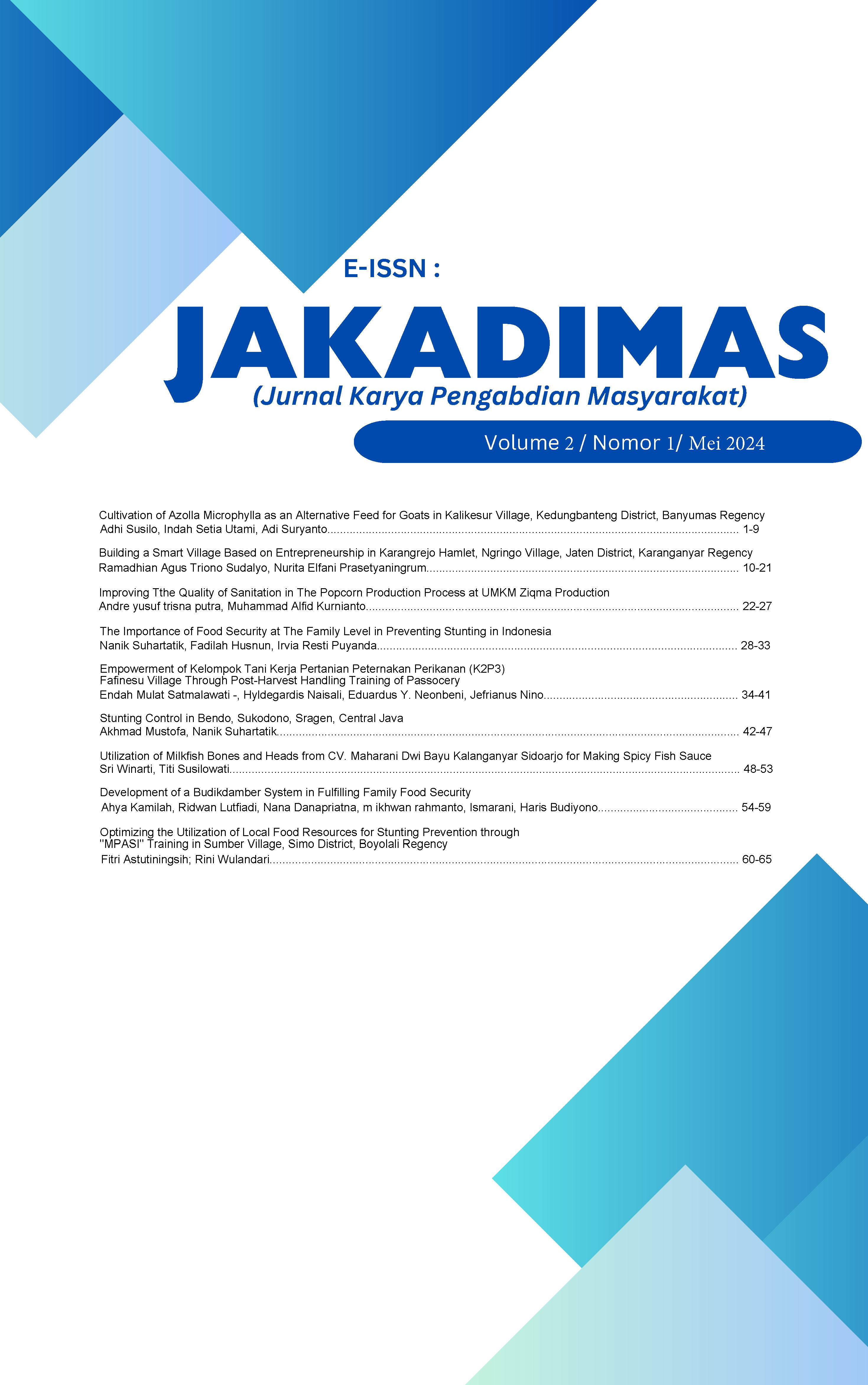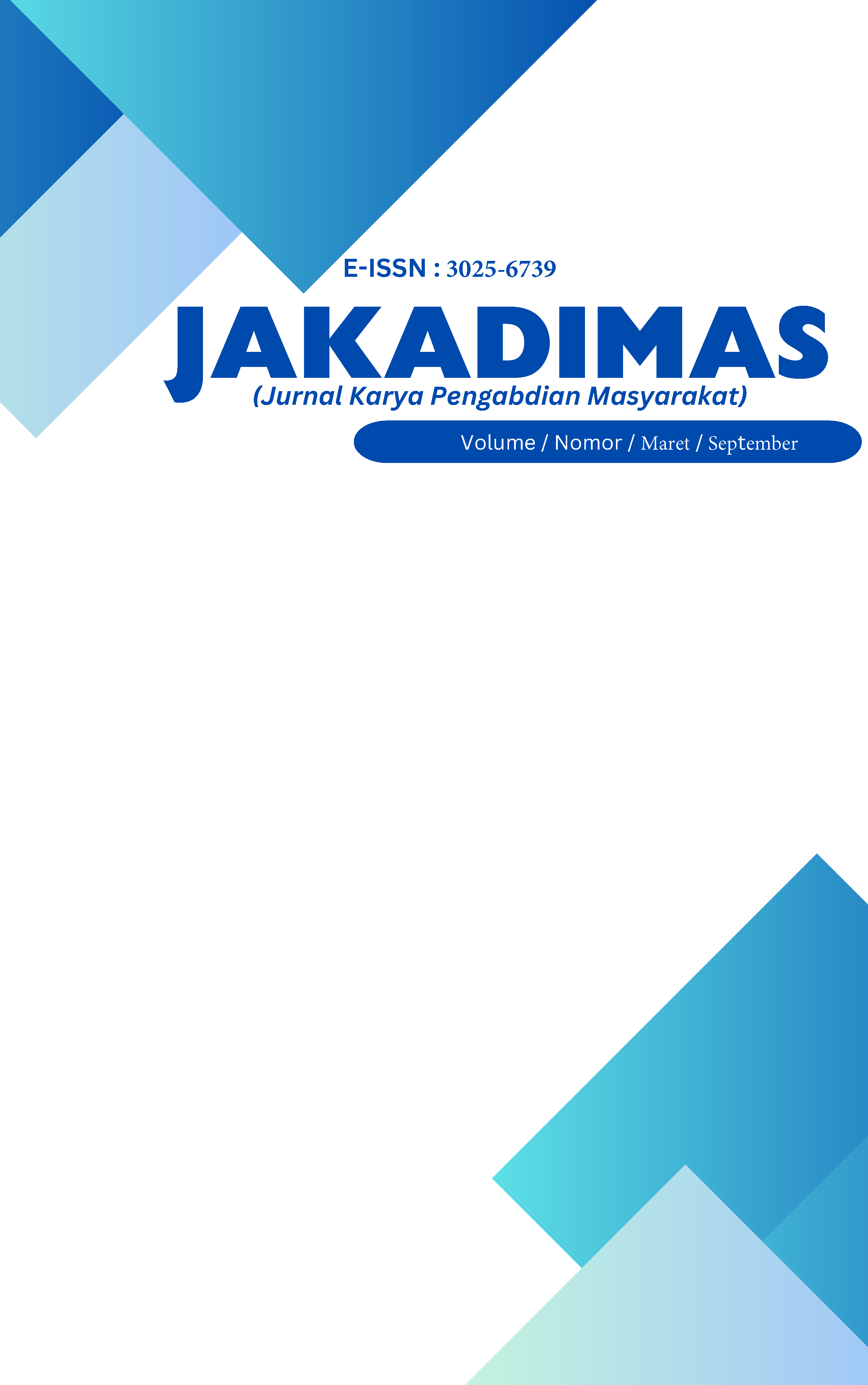Cultivation of Azolla Microphylla as an Alternative Feed for Goats in Kalikesur Village, Kedungbanteng District, Banyumas Regency
Budidaya Azolla Mycrophilla Sebagai Alternatif Pakan Ternak Kambing di Desa Kalikesur Kecamatan Kedungbanteng Kabupaten Banyumas
DOI:
https://doi.org/10.33061/jakadimas.v2i1.10101Keywords:
Azolla mycrophilla, cultivation pond, alternative feed, bio-organic fertilizerAbstract
Kalikesur Village, located in the Kedungbanteng District of Banyumas Regency, possesses significant prospects in agriculture and animal husbandry. Typically, the villagers continue to rely on forage fodder, such as grass and agricultural waste, to feed their poultry and cattle. Hence, the objective of our community activity is to acquaint the inhabitants of Kalikesur Village with the Azolla plant as a substitute feed and as a material for bio-organic fertilizer. We also want to teach cultivating methods so that an Azolla business group can be established. Getting to know one another, sharing insights on the value and advantages of Azolla for animal feed and bio-organic fertilizers, constructing basic bio-flocks (ponds), learning how to cultivate and harvest Azolla, creating fertilizer with Azolla as a base, and initiating new Azolla marketing campaigns on social media were some of the activities that took place. One of the program's many results is the technology transfer for growing Azolla, which may be used as a bio-organic fertilizer and a nutritional feed alternative. Additionally, it creates instructions for growing Azolla and using it as bio-organic fertilizer and animal feed. Additionally, the program provides manuals on the business analysis of Azolla. It contributes to the increase in livestock production, thereby enhancing the income and welfare of community service partners and the surrounding region.
References
Agus, A. A. (2016). Keluarga masyarakat pedesaan dalam kondisi transisi kehidupan masyarakat tradisional menuju masyarakat modern. Seminar Nasional Pendidikan Ilmu-Ilmu Sosial Membentuk Karakter Bangsa Dalam Rangka Daya Saing Global Indonesia Universitas Negeri Makassar, 29 Oktober 2016.
Ali, N., Hidayat, N., & Yuwono, P. (2020). Analisis potensi pengembangan ternak sapi potong di Kabupaten Banyumas. ANGON: Journal of Animal Science and Technology, 3(2), 310-316. https://doi.org/https://doi.org/10.20884/1.angon.2020.2.3.p310-316
Anugrah, I., Sarwoprasodjo, S., Suradisastra, K., & Purnaningsih, N. (2014). Sistem pertanian terintegrasi - Simantri: Konsep, pelaksanaan, dan perannya dalam pembangunan pertanian di Provinsi Bali. Forum Penelitian Agro Ekonomi, 32(2), 157-176
Bambang, B. (2016). Pemetaan potensi desa di Kabupaten Banyumas. EcceS: Economics Social and Development Studies, 3(2), 123-155. https://doi.org/10.24252/ecc.v3i2.2902
Bujak, A., & Bujak, J. (2022). Azolla's use as a biofertilizer and livestock feed. Ferns: Biotechnology, Propagation, Medicinal Uses …. https://doi.org/10.1007/978-981-16-6170-9_29
Hartono, R. (2021). Zero waste agriculture (konsep pertanian tanpa limbah). ULPPTP Kabupaten Pasuruan. https://disperta.pasuruankab.go.id/isiartikel/zero-waste-agriculture-konsep-pertanian-tanpa-limbah-
Rahardjo. (2016). Sosiologi Pedesaan (2 ed.). Universitas Terbuka.
Soekanto, S. & Sulistyowati, B. (2017). Sosiologi Suatu Pengantar. Jakarta: Rajawali Press
Sunaryo, D. (2020). Optimalisasi pemanfaatan tumbuhan Azzola (Azolla pinnata) sebagai pemberdayaan sumber pendapatan masyarakat penerima bantuan langsung tunai yang terdampak Covid-19 di Desa Sukaratu Kecamatan Cikeusal Kabupaten Serang. Humanism: Jurnal Pengabdian Masyarakat, 1(2). https://doi.org/10.30651/hm.v1i2.5487
Susilawati, N. (2012). Sosiologi pedesaan. Universitas Negeri Padang
Swain, B. K., Naik, P. K., & Beura, C. K. (2022). Nutritive value of azolla as poultry feed-a review. Indian Journal of Animal Nutrition, 39(1), 1-11. http://dx.doi.org/10.5958/2231-6744.2022.00001.9
Syamsiyah, J., Herdiansyah, G., Hartati, S., & Suryono. (2021). Pengenalan budidaya Azolla untuk mendukung pengembangan pertanian organik. PRIMA: Journal of Community Empowering and Services, 5(1), 38-46. https://doi.org/https://doi.org/10.20961/prima.v5i1.44865
Widianingrum, D. C., Dewi, N., Fanata, W. I. D., & Sholikhah, U. (2021). Pengembangan budidaya Azolla mycrophilla sebagai alternatif pakan ternak dan pemanfaatannya sebagai pupuk bio organik di wilayah masyarakat Desa Baletbaru, Sukowono. Jurnal Abdimas Madani dan Lestari (JAMALI), 3(1), 11-19. https://doi.org/https://doi.org/10.20885/jamali.vol3.iss1.art2
Downloads
Published
How to Cite
Issue
Section
License
Copyright (c) 2024 Adhi Susilo, Indah Setia Utami, Adi Suryanto

This work is licensed under a Creative Commons Attribution-ShareAlike 4.0 International License.
Authors who publish with this journal agree to the following terms:
- Copyright on any article is retained by the author(s).
- The author grants the journal, right of first publication with the work simultaneously licensed under a Creative Commons Attribution License that allows others to share the work with an acknowledgment of the work’s authorship and initial publication in this journal.
- Authors are able to enter into separate, additional contractual arrangements for the non-exclusive distribution of the journal’s published version of the work (e.g., post it to an institutional repository or publish it in a book), with an acknowledgment of its initial publication in this journal.
- Authors are permitted and encouraged to post their work online (e.g., in institutional repositories or on their website) prior to and during the submission process, as it can lead to productive exchanges, as well as earlier and greater citation of published work.
- The article and any associated published material is distributed under the Creative Commons Attribution-ShareAlike 4.0 International License








